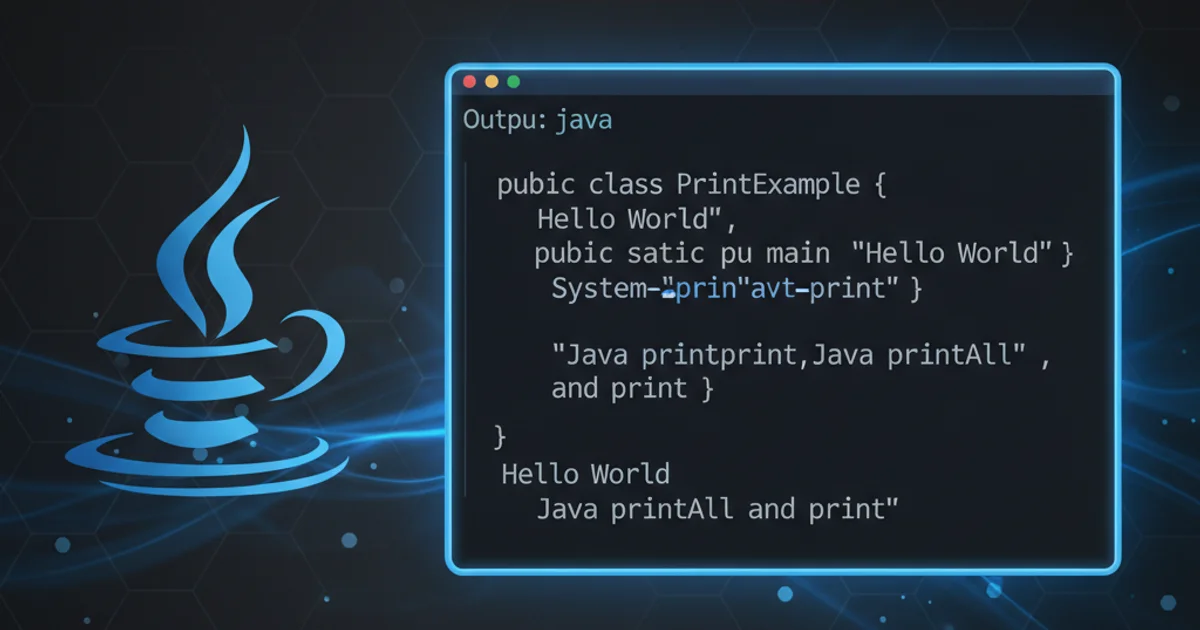Java printAll and print
Categories:
Understanding Java's print() and println() Methods

Explore the fundamental differences and common use cases for Java's System.out.print() and System.out.println() methods for console output.
In Java programming, displaying output to the console is a fundamental operation. The System.out object provides two primary methods for this purpose: print() and println(). While both are used for output, they behave differently, especially concerning line breaks. Understanding these differences is crucial for controlling the format and readability of your program's console output.
The System.out.print() Method
The print() method is used to display its argument to the console without appending a new line character at the end. This means that subsequent output operations will continue on the same line, immediately following the previously printed content. It's particularly useful when you want to concatenate multiple pieces of information on a single line or build a line of output incrementally.
public class PrintExample {
public static void main(String[] args) {
System.out.print("Hello ");
System.out.print("World");
System.out.print("!");
System.out.print("\n"); // Manually add a newline
System.out.print("This is on a new line.");
}
}
Example demonstrating System.out.print() behavior.
The output of the above code would be:
Hello World!
This is on a new line.
Notice how "Hello ", "World", and "!" appear on the same line. A newline character (\n) was explicitly added to move the cursor to the next line for the final print statement.
The System.out.println() Method
In contrast, the println() method (short for 'print line') displays its argument to the console and then automatically appends a new line character. This moves the cursor to the beginning of the next line, ensuring that any subsequent output will start on a fresh line. This is often the preferred method for displaying discrete messages or when each piece of information should occupy its own line.
public class PrintlnExample {
public static void main(String[] args) {
System.out.println("First line.");
System.out.println("Second line.");
System.out.println("Third line.");
}
}
Example demonstrating System.out.println() behavior.
The output of this code would be:
First line.
Second line.
Third line.
Each println() call automatically moves to the next line, making the output clean and easy to read.
System.out.println() without any arguments to simply print a blank line, which can be useful for formatting output and improving readability.When to Use Which Method
Choosing between print() and println() depends entirely on your desired output format. Here's a quick guide:
Use
print()when:- You need to build a single line of output from multiple smaller strings or variables.
- You are printing elements of an array or collection on the same line, separated by spaces or commas.
- You want to prompt a user for input on the same line as the prompt message.
Use
println()when:- Each piece of information should appear on its own line.
- You are displaying log messages or status updates that should be distinct.
- You want to add a blank line for visual separation.
flowchart TD
A[Start Output] --> B{Need New Line?}
B -- Yes --> C[Call System.out.println()]
B -- No --> D[Call System.out.print()]
C --> E[Output Printed with New Line]
D --> F[Output Printed without New Line]
E --> G[End Output]
F --> G[End Output]Decision flow for choosing between print() and println().
Common Pitfalls and Best Practices
While print() and println() are straightforward, there are a few things to keep in mind:
- Forgetting Newlines with
print(): If you useprint()repeatedly without manually adding\n, all output will appear on a single, potentially very long, line, making it hard to read. - Overusing
println(): While convenient, excessive use ofprintln()can lead to too much vertical space in your console output if not managed properly. - String Concatenation: Remember that you can concatenate strings and variables directly within both
print()andprintln()methods using the+operator. For example:System.out.println("The value is: " + myVariable); - Formatting Output: For more complex formatting needs, especially with numbers and dates, consider using
System.out.printf()(formatted print), which offers C-style formatting capabilities.
System.out object is an instance of PrintStream, which provides various overloaded print() and println() methods to handle different data types (e.g., int, double, boolean, char[], Object).